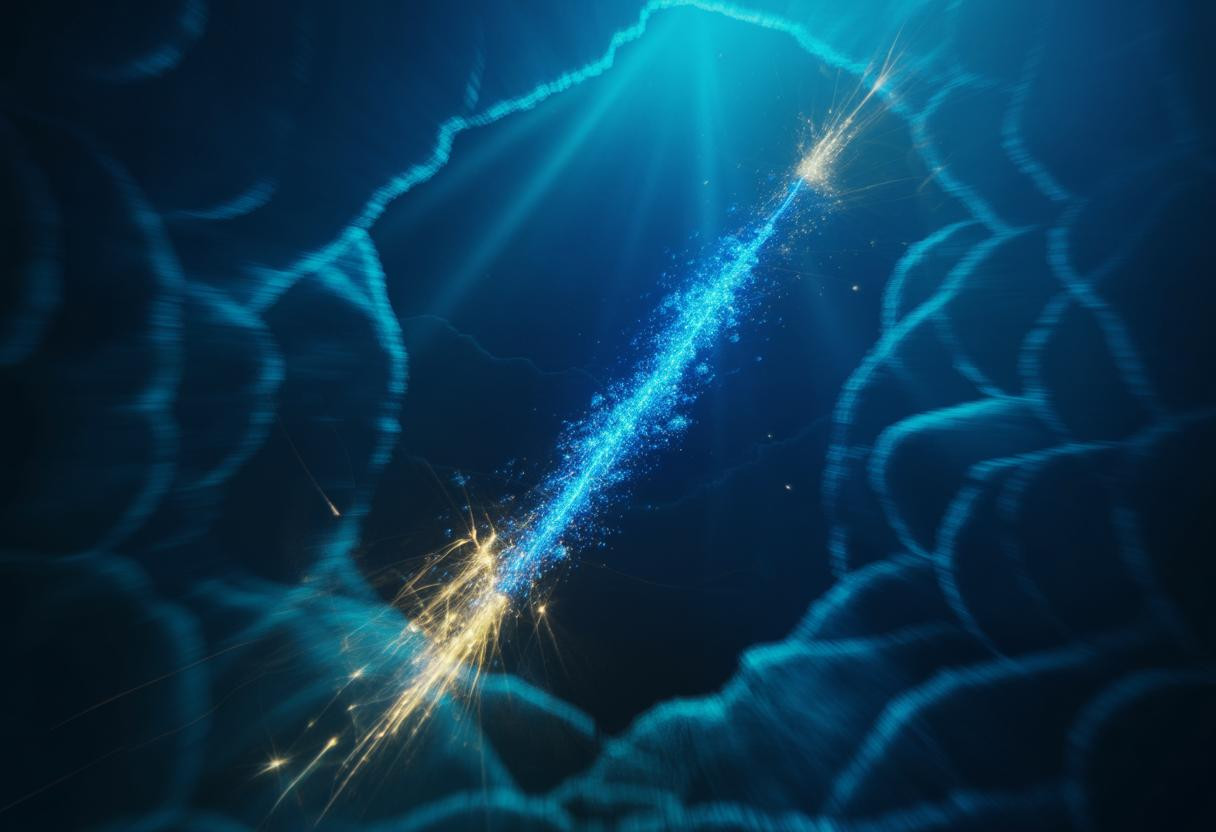Scientists have just captured something extraordinary lurking 3,450 meters beneath Mediterranean waters – a cosmic particle so energetic it rewrites our understanding of the universe’s most violent phenomena. This wasn’t just any detection; at 220 peta-electronvolts, this neutrino carried 30 times more energy than any previously recorded, offering our first glimpse into cosmic events so extreme they challenge the laws of physics as we know them.
The deep-sea discovery that’s revolutionizing space science
The KM3NeT neutrino telescope, positioned strategically in the Mediterranean’s depths, represents a technological marvel spanning cubic kilometers of seawater. Unlike traditional space telescopes that look outward, this underwater observatory captures invisible messengers from the cosmos’s most distant and violent events.
What makes this detection unprecedented isn’t just the energy level – it’s the revelation that particles from the edge of observable space can travel billions of light-years virtually unimpeded. While electromagnetic radiation gets absorbed or scattered by cosmic dust, neutrinos pass through entire planets as if they were empty space, carrying pristine information about their origins.
The February 2023 detection involved sophisticated advanced detection technology featuring spherical optical modules housing 31 ultra-sensitive photomultiplier tubes each, designed to catch the faint blue flash of Cherenkov radiation when cosmic neutrinos interact with seawater.
Why this cosmic messenger changes everything we thought we knew
Energy levels that shouldn’t exist naturally
The 220 peta-electronvolt energy reading represents something extraordinary in cosmic physics. To put this in perspective, this single particle carried 100 million billion times more energy than visible light. Such extreme energies suggest acceleration mechanisms near supermassive black holes or during gamma-ray bursts – events so violent they can outshine entire galaxies for brief moments.
Dr. Paschal Coyle from the Marseilles Particle Physics Centre explains that these energies “probe cosmic accelerators operating at efficiencies we’re only beginning to understand.” The detection validates theories about active galactic nuclei serving as cosmic particle accelerators, potentially solving decades-old mysteries about ultra-high-energy cosmic ray origins.
Technological breakthroughs beneath the waves
The detection system itself represents a leap forward in material science innovations, with each digital optical module engineered to withstand crushing deep-sea pressures while maintaining extraordinary sensitivity. The array’s real-time data transmission capabilities through submarine cables enable immediate analysis of cosmic events happening billions of light-years away.
Unlike Antarctica’s IceCube detector, KM3NeT’s Mediterranean location offers unique advantages: clearer water for longer detection ranges and strategic positioning for monitoring the galactic center where the most energetic cosmic phenomena occur.
What this means for understanding our cosmic neighborhood
This detection opens an entirely new window into multi-messenger astronomy – the practice of observing cosmic events through multiple channels simultaneously. When combined with gravitational wave detectors and electromagnetic observatories, neutrino astronomy provides a complete picture of the universe’s most extreme events.
The implications extend beyond pure science. Future developments will likely incorporate AI-driven data processing systems capable of real-time event correlation across multiple detector networks, potentially predicting and identifying cosmic catastrophes as they unfold.
Practical applications emerging from cosmic particle detection
Medical and industrial spin-offs
The ultra-sensitive photodetection technology developed for neutrino astronomy is already finding applications in medical imaging and cancer treatment. The precision timing systems required to track neutrino interactions are advancing GPS accuracy and deep-sea communication networks.
Future space exploration advantages
Understanding high-energy cosmic particle behavior will be crucial for protecting astronauts during deep space missions. The detection methods pioneered by KM3NeT could inform shielding technologies for Mars missions and lunar bases, where cosmic radiation poses significant health risks.
The expanding frontier of cosmic particle hunting
Plans for next-generation detectors include expanding coverage to achieve full-sky monitoring through international collaborations. The success of the Mediterranean detection is driving proposals for similar observatories in the Atlantic, Pacific, and Indian Oceans, creating a global network capable of triangulating cosmic sources with unprecedented precision.
Scientists predict that within the next decade, autonomous systems technology will enable self-maintaining underwater detector arrays, dramatically expanding our capacity to monitor cosmic phenomena while reducing operational costs.
A new chapter in humanity’s cosmic story
This breakthrough represents more than technological achievement – it’s fundamentally changing how we perceive our place in the universe. By detecting particles that originated near black holes billions of light-years away, we’re not just observing distant events; we’re directly sampling the universe’s most extreme physics. This single neutrino detection proves that the cosmos’s most violent and energetic phenomena are not beyond our reach, but rather scientific research breakthroughs waiting to reveal their secrets through human ingenuity and technological precision.
